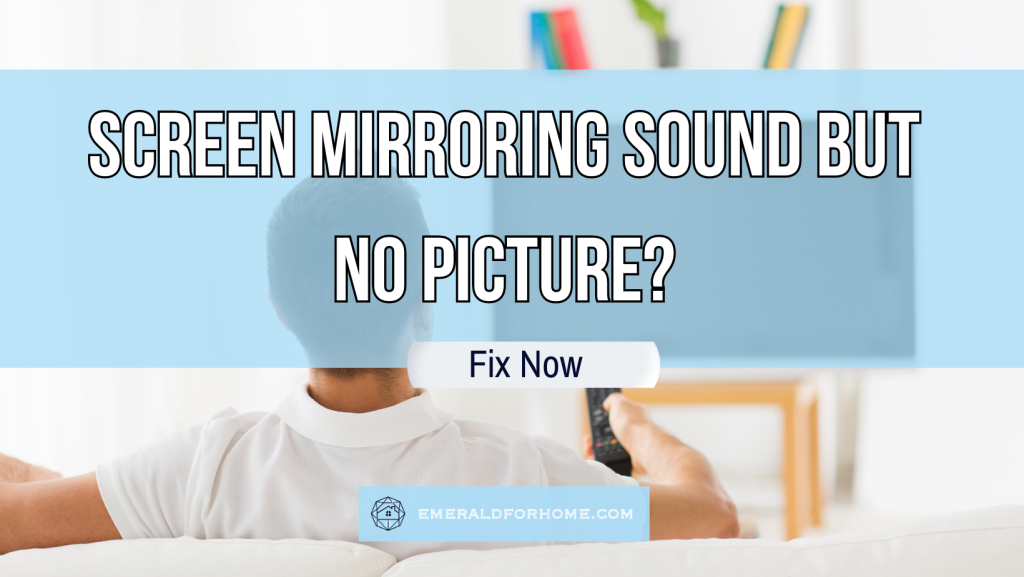If your screen mirroring display won’t work, it could be due to the following factors:
- The app/program doesn’t allow screen mirroring.
- Your connecting devices are on different Wi-fi networks.
- Your TV could have damaged hardware.
- You’re trying (and failing) to use public Wi-fi networks to screen mirror.
It’s understandable to feel annoyed when your screen mirroring fails to show video, but try not to let it get to you while troubleshooting – the fixes below won’t take longer than a few minutes each, so stay calm and the issue will be dealt with in no time at all!
Why Is My Screen Mirroring Audio Without Display?
The App You’re Using Doesn’t Permit Screen Mirroring

If your device screen mirroring has sound, but no picture display, there’s a big chance that it’s due to app incompatibilities with your TV.
This tends to happen with streaming services (i.e. Peacock, Netflix) in order to protect their catalogues full of copyrighted content. You can actually see similar practices with game consoles, with the PS5 disabling content sharing to Alexa and other third-party devices!
Why Is My Screen Mirroring Sound But Not Picture?
It may seem a little weird for your screen mirroring to have working sound without picture, but there’s actually a pretty good reason why only one of these might be excluded!
Visual data is a lot more complicated than audio data, making it tricky to transmit to your TV’s display – especially in real-time! In these cases, the issue stems from your app (or device) lacking the capability to mirror its screen on your TV.
Alternatively, your platform might be capable of screen mirroring properly – it just isn’t allowed to! Your device may be blocking the shared display as a security measure, reducing the risk of sensitive information being captured on-screen.
In both instances, you’ll want to look for a more compatible app to screen mirror properly – ideally, you’ll want to ensure that your screen-mirroring app was designed by the same company who made your TV’s firmware. If that isn’t available, we’d recommend trying out Chromecast due to its (relative) neutrality, letting it service a wide variety of different brands.
Streaming Device And TV Are On Different Wi-fi Networks
If your screen mirroring has sound but not picture despite listed compatibility, there’s a chance that your devices are using different Wi-fi networks to function.
As we mentioned earlier, video data is more complicated to transfer than audio data. Screen mirroring is best done on the same network, as the direct communication link reduces bandwidth demand and latency, making it easier for your TV to handle both audio and video data.
Try to ensure that both devices are on the same Wi-fi network – double check if your mobile device has mobile data enabled, as it may default to using that without informing you.
Your TV’s Hardware May Be Compromised
Your TV’s screen mirroring capabilities may be hampered by hardware issues, such as broken HDMI cables or damaged/loose receiver ports.
HDMI cables are responsible for transmitting audio and video data at the same time with one connection, so any damages incurred – cuts, bends, or even simple wear-and-tear – could disrupt the transmitted signal’s fidelity. Use a spare HDMI cable to verify if this is the problem.
Alternatively, the problem could also be due to receiver port issues – your HDMI’s port could be loose, preventing secure connections. This may be caused by loose debris lodged inside the port, which can be cleaned with gentle brushing or even compressed air.
If the connection remains loose, you may want to get it appraised by a professional technician.
There’s a Resolution Mismatch With Your TV and Device
While it’s rare, a resolution disparity could explain why your screen mirroring only shares sound without video data. During the screen mirroring process, your device and TV are trying to reconcile how they’ll display content on-screen, with mismatches hampering the negotiation process.
This may lead to the display failing to load, if the resolution difference can’t be settled. You can test for this by setting both to use only the default resolution, though it may not work if the display resolution options differ too much between your TV and screen mirroring device.
The reason for this issue’s rarity is because screen resolution mismatches more commonly manifest in other ways – namely downsizing (to native resolution), black bars on-screen, distorted images, or even vertical or horizontal lines on your TV!
You’re Trying to Use Unfamiliar Public Networks For This
Lastly, screen mirroring may fail to share video data if you’re using public networks. While public networks often boast competitive network speeds on paper, they’re often bogged down by certain discrete factors many users overlook – here’s a quick rundown on the essentials.
Network Traffic Congestion
While the offered bandwidth should be sufficient on paper, remember that public networks maintain dozens or even hundreds of users at a time. This limits how much data you can transfer in real-time, which would in turn lead to problems while screen mirroring.
Wi-fi Security Settings
Some public networks also have security restrictions in place prohibiting certain types of connections, with streaming apps and Alexa being common exclusions for dorm Wi-fi and other similar networks.
While this won’t prevent you from accessing content on your mobile device, you’ll need to change your TV’s main netwok to screen mirror effectively.

